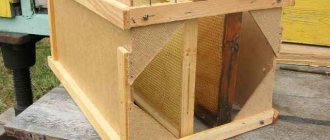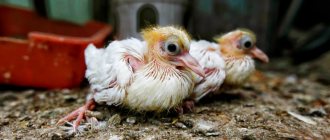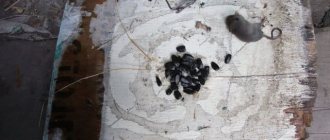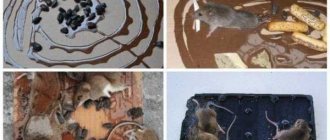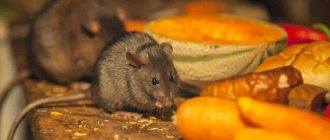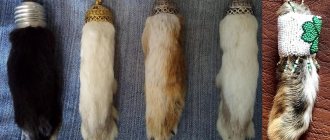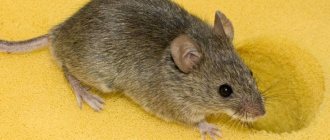A mousetrap is the main means of controlling rodents. To quickly get rid of rats, you need to choose the right type and location of the device, and know how to install a mousetrap. A platform, a spring mechanism and a bait - this is the standard design of a mousetrap.
- How a mousetrap works
- Self-installation instructions Selecting a location
- Installation of a gatehouse
- Location
- Disposal
- Spring
TOP 7 best baits for mice in a mousetrap
There are 7 types of foods that a rodent will not refuse. For example:
Salted or smoked lard
This type of bait has been tried by many generations of people. It is desirable that it be fresh lard, with a fragrant smell. Smoked lard has similar characteristics. It is better not to use old lard, which has a very specific aroma, as it is unlikely to interest mice.
Vegetable oil
Naturally, an unrefined product with a pleasant aroma is suitable for these purposes. It is enough to take a crust of bread and moisten it with vegetable oil, and then use it for its intended purpose.
Grains and baked goods
Fresh baked goods, which include whole grains or bran, perfectly attract gray aggressors. If you moisten the crust of bread with sunflower oil, it will certainly attract pests, such as mice. The effect can be increased if the cereals are treated with rat poison.
Cold smoked fish
This product is like a magnet, attracting gray aggressors. Naturally, you need to take only a quality product. If you use rotten, unfit for consumption fish, mice will avoid such a trap.
Sausage
They also attract mice because they contain odor and taste enhancers. Despite the fact that sausages are literally stuffed with chemicals, they can serve as good bait. Of course, it is better to use homemade sausage, which does not contain chemical components.
Cheese
There is an opinion that cheese is a favorite treat of mice and rats. No one can prove this or disprove this. But cheese, in any form, and especially smoked, can serve as an excellent bait. In any case, this myth can be refuted or proven.
Raw minced meat with onions
This method is more suitable for catching rats. Of course, a mouse is unlikely to refuse such a delicacy, so such bait works flawlessly. You can add a little rat poison to the mixture of ground meat and onions so as not to upset the balance of flavors. For 10 parts of minced meat, you should take at least 2 parts of onion, but you should not take more, so as not to upset the balance of flavors.
https://youtube.com/watch?v=_0KMG-FBzeM%3Frel%3D0
How to catch a mouse
To catch a mouse in an apartment in a trap, you need to understand where and where the rodent comes from.
— Unlike rats, mice search for food only at a distance of 10-25 meters from their habitat. Traps should be placed in areas where mice are most likely to appear.
https://youtube.com/watch?v=WqoDx3MSowE%3Ffeature%3Doembed
Mice prefer to travel along walls and other vertical structures. Mice are very inquisitive and explore every new object placed in their feeding territory.
If the mouse is not immediately caught, the device can be moved to another location, writes Michael F. Potter, a specialist at the University of Kentucky College of Agriculture.
Mice eat grains and seeds, nuts, oils and sweets. Mice are nocturnal animals, and during the dark time of day they are able to go out in search of food up to 30 times. They leave behind them a black oblong droppings 0.3-1.2 cm long, thanks to which their recent appearance is easily disavowed.
But before you start arranging, it is better to first spend time preventing rodents from appearing in unwanted places. Cracks and holes larger than a quarter inch wide should be repaired.
Weak points: holes for water pipes in the wall and the gap under the door. To make the room less attractive, you need to keep it clean: remove leftover food.
After this, basic measures, if necessary, can be supplemented with the placement of special anti-mouse products.
To check whether there really are mice in the house, you just need to sprinkle a little flour in the “suspicious” areas where the animals supposedly live, and see if traces appear the next morning.
Depending on your personal preferences, you can choose different methods of catching mice - from harmless to quite cruel. It should be kept in mind that these rodents rarely leave their nests during the day, so you need to set traps at night.
Interesting fact. Mice's incisors grow throughout their lives, so animals are forced to constantly grind them down, gnawing on everything. With the help of its teeth, the animal can destroy structures made of wood, concrete and even metal.
A mouse is dangerous to humans because it can cause a dangerous infection, especially if it gets into food
Killer Mousetrap
An old, tried and true, but not always effective way to catch a mouse is to use a mousetrap. The latter can be industrially manufactured and vary in design. The principle of operation of such a device is to lure a rodent and then kill or injure it through a special mechanism.
https://youtube.com/watch?v=0c1PC55_z6M%3Ffeature%3Doembed
Small cute animals only look harmless and fragile, but in fact, the presence of mice in the house means a lot of trouble.
How to catch a mouse in an apartment?
In some cases, you still have to be interested in the answer to such a question.
Cleanliness is the enemy of the rodent
By keeping the house clean and following the recommendations, you can create conditions that become unbearable for mice to live in and they quickly retreat back home.
- Periodic general cleaning will help to avoid the accumulation of garbage, leftover food in corners, table drawers and other inaccessible places, and therefore rodents will not have the opportunity to profit from anything.
- Products are stored in tightly sealed jars or metal containers with a heavy lid.
- Household and kitchen waste is collected in buckets with lids and removed from the apartment in a timely manner.
- Install grilles on ventilation ducts, seal holes in the floor and baseboards.
Where to put mousetraps
If there are a lot of people at home during the day, it is better to set mousetraps at night. Rats and mice do not like to leave their holes during the day. You can find out that they were in the apartment by the excrement that they leave in the places where they stay. Rodents do not like open spaces, so they move along the walls. That's where you need to place mousetraps.
To enter an apartment, they make holes with a diameter of 4 cm or use any holes, even the size of a coin. Walk through the kitchen, carefully examine all the walls and dark corners. If you find a hole, place a mousetrap near it. Sometimes rodents run after household appliances and furniture. Place traps near holes or along the wall, at a distance of 60-90 cm from each other. You can put one under the oven, in the pan compartment.
Where and how to install
It is recommended to place a mousetrap in a place where rodents most often live, for example, in the kitchen. This must be done using rubber gloves so that the human smell does not scare off the mice.
Can be installed in the following areas:
- In the space under the furniture.
- Wall voids, if any.
- If there are pantries, a basement, a cellar or other premises that are intended for storing food, the installation should be done there.
- You can also place mousetraps on cabinet shelves that are needed to store food supplies.
If there are no specific areas, you can place the mousetrap where it will not pose a danger to pets and children. Sooner or later, rodents attracted by the scent of the bait will fall into the trap.
Installation rules and location selection
Owners often think about the intricacies of placing a mousetrap, because a colony of rodents can reach the scale of a disaster. Pests spoil wiring, food, and are also carriers of infections. The process is simple if you follow step-by-step instructions on how to charge a mousetrap depending on its type:
- With a spring. You need to place the bait on the hook by pulling the spring.
- Traps. Food must be put in parts.
- Electronic systems are turned on according to the instructions supplied with the device on how to install a mousetrap from the manufacturer.
Traps should not be placed within the reach of children or pets. It is not a mouse that can get into a charged device, but one of the household members. If it is not possible to place the device in a safe place, you need to choose the right trap. Mousetraps that are equipped with a loop are also dangerous, because... the wire in them is very sharp and can cut the skin. It is worth considering the options of pipes, cages and boxes.
You can place fishing devices in any convenient place. From time to time individuals will come across. But it is much more effective to install traps with bait in the mouse habitat area, where the path from the nest to the food is laid.
Rodents usually feed in the spaces between furniture, under cabinets, and in drawers. And apartments with plasterboard partitions are a paradise for mice.
You can understand where pests are most often found by looking at waste products and spoiled things. Experts recommend placing traps near these places. You can charge the mousetrap near the baseboard or between the cabinets in the kitchen. There should be several traps, because trapping is carried out in the dark, when it is impossible to reinstall the device.
For many years people have been puzzled by the question of how to quickly and effectively rid their home of rats and mice. Despite the large number of modern methods, the decision to put a mousetrap in the house is still popular.
Self-installation instructions
To ensure that the rat is definitely caught in the trap, the mousetrap is installed in places where the animals live most often.
The mechanism must be set up correctly. This step is especially important for traditional spring mousetraps.
After catching the animal, the rat should be pulled out in such a way as not to damage the fingers.
Selecting a location
It is advisable to install the device in places where rodent colonies accumulate.
To determine the location of their home, use the following landmarks:
- traces on the floor of the apartment that remain from the rubbing fur of the pest;
- tracks from paws on the floor;
- animal excrement;
- squeaking or rubbing of paws (to hear, create absolute silence).
Attention! If you see one dead rat, be prepared to find a colony of them around. Carefully inspect the floor and walls for cracks and holes.
Rodents can hide in them
Carefully inspect the floor and walls for cracks and holes. Rodents can hide in them.
Favorite locations of rats and mice:
- under the cabinet;
- for furniture;
- in the upper part of the basements;
- between desk drawers or boxes.
If you find a pest habitat, place a mousetrap as close to it as possible.
Installation of a gatehouse
The main stage is to properly adjust the mechanism of the trap and charge it without damaging your own fingers.
Make a threader (it can be supplied ready-made), fix it in a spring, press the latter to the body and load the bait - this is how to properly install a “classic” mousetrap.
To make your own threader, take a wire similar to a guitar or balalaika string, 20 to 25 cm long. Bend it in half.
Step-by-step instructions for installing a gatehouse:
- Turn the trap with the holes facing you.
- Pass the line from top to bottom, from right to left.
- When the threader has entered the body of the rat trap, insert the thread there.
- Pull the line up.
- Thread the wire in the opposite direction (bottom to top, from the left hole to the right).
- Throw the thread over the spring.
- Insert into the threader and pull down.
- Turn the rat trap with the bottom part towards you.
- Assemble the spring to the device and tighten the thread.
After you have started the mechanism, you should fill the rodent bait.
Location
In homes where children and pets live, open mousetraps should be avoided. Traps with a loop mechanism are also not suitable. Choose “humane” cage type traps that do not kill the animal.
Place the device in the area between the rodent's nest and food.
It is better to put 3-4 mousetraps. Rats are more active at night, so it will not be possible to recharge the mechanism in time.
It is advisable to choose an area protected from moisture. This will prevent damage to the mechanism and bait.
Traps are also installed in non-residential areas: in the basement, barn, garage, bushes.
Disposal
When the device is no longer needed, it is disposed of as household waste. The rat trap can be thrown into a general landfill and burned.
Important! Do not rush to get rid of the mousetrap when all the rodents have been destroyed. The service life of the device can be up to 40 years
Killer methods of getting rid of mice
One of the cruelest ways to catch a mouse is to set a mousetrap. You can buy it in a specialized store. Following the instructions, set up a mousetrap and place it in the place where an uninvited guest is most likely to appear.
Use a strong-smelling product as bait:
- Animal feed.
- Smoked sausage.
- Peanut butter.
- Spoiled meat.
After the mouse falls into the trap, take it out and throw it away, or better yet, bury it so that it does not appear in your dreams later.
Types of mousetraps
Mousetraps come in different types, from traditional spring ones to electric ones. It is necessary to install mousetraps in those places where, in your opinion, the rodent lives:
- In the closet.
- In a drawer.
- In the storage room.
- etc.
One mousetrap may not be enough to catch rodents, and using several devices, you can catch several mice at a time. Since mice are carriers of many dangerous diseases, regularly check the mousetrap and throw away the corpse, but use protective gloves and even a protective mask to protect yourself from contact with dangerous bacteria.
You can kill mice in another way by adding poison to the food, but as a result, if the mouse returns to its hole and dies there, the unpleasant smell of a decomposing corpse will spread throughout the apartment.
Adviсe:
- If you decide to buy a mousetrap, then remember that electric mousetraps are much more effective than mechanical ones.
- Close mouse holes only if you are sure that you have gotten rid of all the mice, otherwise they will gnaw new holes or die behind the wall from dehydration, which is also not pleasant.
- As soon as you find uninvited guests, act quickly, as mice can bring friends or quickly breed.
- Place poisoned baits out of the reach of pets and children.
Pros and cons of homemade devices
When there are rodents at home, it is not necessary to immediately purchase poisons that are very toxic to people and animals. The simplest and safest solution in all respects would be a mousetrap.
The classic version can be purchased at a hardware store. Only it has one significant drawback - if there are a lot of mice, you will have to spend a lot of money. The mechanism is simple, but its work is one-time only. After each capture you have to recharge the device. The conclusion follows from this: leaving a few mousetraps at the dacha and leaving with the hope that upon return the rodents will be exterminated will not work.
As practice has shown, most homemade traps, in addition to reusable use, have a number of advantages:
- Does not contain poisons. Most chemicals used in rodent baiting are toxic and can cause illness in humans or pets. Mousetraps made from improvised materials do not contain hazardous substances, as they operate mainly mechanically.
- There is no need to leave the premises. Professional rodent exterminators also use toxic substances. It is better not to appear indoors for some time after treatment, as there is a risk of intoxication. Mousetraps are completely safe in this regard.
- There is no threat of unsanitary conditions. The caught mouse will die on the spot and the remains will be easy to dispose of. Being poisoned, she will most likely die in her hole, from where it will be impossible to get her. The body, as it decomposes, will begin to emit an unpleasant odor and attract carrion insects.
- Saving. Homemade designs save the family budget from unnecessary expenses on purchased mechanisms. They are made from simple things that can be found in every home.
Advice: when there is a threat of a large invasion of mice, rather than two or three hosts, it is better to give preference to reusable traps. With them you don’t have to make new ones all the time and install them around the house.
The disadvantages include the fact that a person who is not accustomed to creating various mechanisms and structures needs practice. His first complex traps will be ineffective and, most likely, inoperative. It is better to start with simple ones and remember that each model has advantages and disadvantages.
Other methods of rodent control
The methods listed above are not the only methods that describe how to catch mice in the house.
We must not forget about cats, natural-born mouse hunters.
Moreover, it is not at all necessary that it be a rat-catcher cat. In principle, the smell of a cat itself repels mice.
Let us draw your attention to such a method of struggle as. . We do not recommend using it in an apartment
The fact is that the poisoned mouse will gradually begin to decompose, and this unpleasant odor will remain present in the premises for a long time.
We do not recommend using it in an apartment. The fact is that the poisoned mouse will gradually begin to decompose, and this unpleasant odor will remain present in the premises for a long time.
You can also prepare homemade mouse traps, which will save the lives of these rodents.
Thus, the methods of dealing with mice in an apartment are quite varied.
The choice of a particular one is made by everyone independently, because some methods are relatively humane, while others do not leave mice any chance.
Operating principle
The principle of operation is very simple - a rodent, lured by the smell, climbs the ladder to the edge of the bucket. The mouse will try to approach the treat on the bottle.
As soon as the mouse places its paws on it, it will begin to rotate around its axis on the stick. The rodent will fall into a deep bucket from which it will not be able to get out. Thanks to this, taking him outside will not be a problem.
This homemade trap also works on rats, but they are much larger. Some of them, stretching out on their hind legs, will be able to get out of the bucket. Therefore, this mousetrap is more suitable for mice.
How to charge
Before placing a trap in the chosen place, it must be properly prepared for fishing. There are various devices on the market today. It is recommended to choose a removable spring trap or a reusable spring trap. In the latter case, you will have to take out the corpse yourself each time and reload again.
There are inexpensive wooden disposable mousetraps that can be purchased in sets of 3 to 5 pieces. They will come in handy if there are already a lot of rodents in the home and there is a need to install many devices at the same time. The main mistake during installation is putting in too much reserve for the trigger. The bait should be placed so that the spring is triggered even when lightly touching the food, and not at the moment when the animal finishes it.
The bait is placed on the trigger, after which the clamp is carefully cocked. You will need to put a holder on it
And the holder itself is inserted into the trigger mechanism. Another description for installing a spring device is to point the pin in the direction opposite to the spring, pull the metal bracket back towards the pin, press the bracket down with one hand, and place the pin on it with the other.
Next, it must be placed in the hole in the metal plate on the other side. What allows you to hold the bracket in place. All that remains is to lift the plate and release the trigger.
Bait selection
The basis for successful rodent fishing is choosing the right bait. It is widely believed that mice love cheese and, if possible, eat this product exclusively. In fact, rodents prefer cereals, meat products, and sweets.
To catch annoying rodents, it is recommended to choose the following food products as bait:
- Bread that tastes delicious with any vegetable oil. To prepare this mouse delicacy, you need to soak the pieces in oil in advance. It is also a common belief that rodents love peanut butter. You can test this by applying some of the product to white bread.
- Sausage, boiled meat, regardless of type, lard.
- You can also place sweets in the trap, such as pieces of muffins, buns, muffins, or even chocolate candy.
Periodically you need to inspect the mousetrap. If the bait remains intact, there is a good chance that the rodents have access to food sources that they find particularly attractive.
To whet the mouse clan's interest in the bait, you need to replace the old one with fresh products. You also need to replace it after catching each rodent.
When using mousetraps, you cannot ignore the main safety rules.
If the home is inhabited by pets that are overly curious, it is recommended to install the mousetrap in hard-to-reach places, as the device can cause harm to a dog, cat or other family pets.
Precautionary measures
The main thing when installing a mousetrap is not to hurt yourself. This is especially true for spring devices, where the mechanism may slam shut suddenly.
Basic precautions:
- Do not place your fingers under the raised frame.
- Do not place traps in areas accessible to children or pets.
To prevent the mechanism from rusting, periodically lubricate it with oil.
A mousetrap is an effective method of getting rid of rodents. The most modern and convenient are electronic traps. They quickly kill the animal without annoying squeaks and blood. If you feel sorry for the rodent, use cages or swings. After catching the mouse, release it away from the house.
Despite the emergence of a mass of means and methods aimed at exterminating rodents in the house, a considerable number of ordinary people prefer to use effective and time-tested methods, for example, a device for catching mice, traditionally called a mousetrap.
To catch small rodents, it is important to know: how to properly load a mousetrap, choose the appropriate bait and place to install the trap. Devices of equal efficiency can be purchased at specialized retail outlets or made with your own hands.
Preventive measures
Mice appear in a person’s home for a number of reasons. Often, the owners are to blame for this themselves, not paying enough attention to the technical condition of the house or apartment, although mice can appear through open doors. The presence of cracks and holes makes it easy for any rodent to enter the home, but it is warm here and there is always something to eat. Therefore, such owners always complain about the presence of rodents that keep them awake at night.
To understand the cause of this problem, you will have to take the test described at the beginning of the article. If, as a result of answering the questions, it was possible to score a certain number of points, which indicates an affirmative answer “Yes,” then it is necessary to immediately correct the situation. It is necessary to strive to ensure that there are no positive answers at all, then you will not have to encounter rodents. Of course, it will not be possible to fulfill all the conditions, but those that depend solely on the owners are quite possible.
Naturally, it is better to take care in advance to ensure that rodents do not enter your home. Not much needs to be done for this. It is enough to check the apartment or house for the presence of factors that allow rodents to enter the premises. If such conditions exist, they must be eliminated. You may need to redecorate your apartment to get rid of holes and cracks. At the same time, care must be taken to ensure that food is stored so that mice do not get to it. You should not stock up on bulk food products for the long term, filling your pantries with them. As a rule, little remains of such products.
If it so happens that rodents have entered your home, then you should not hesitate to get rid of them. It is enough to make a simple trap and use fragrant bait and the problem can be solved. The sooner this happens, the better, before the rodents have time to build a nest and begin to reproduce, then it is much more difficult to deal with them.
https://youtube.com/watch?v=LMjxfzUjDOQ%3Frel%3D0
How to make a Zürner mousetrap at home
A design similar to the previous one is a Zürner trap at the base with a box, which is masked on the outside with a sloping lid and lined with galvanized iron on the inside. Two opposite sides have inlet holes or windows; opposite each there is a fixed bridge on a hinge, the ends of which rest on the edges of the holes. The inner ends without supports form a long bridge stretched “over the abyss”. A hook with bait is attached above the area where the bridges close, fixing it on the lid of the box.
The design works according to the following principle:
- the mouse runs along the bridge to the bait,
- under its weight the bridge bends and the animal falls to the bottom,
- the bridge returns to its original position.
Is it possible to make a trap at home with such a device? This is possible, and the process of constructing the structure will be many times simpler than the process of constructing the previous “top” mousetrap.
//www.youtube.com/embed/maoOgZlwctc?feature=oembed
How to charge
What is the best mousetrap and how to charge it before use? You can choose any trap. But work carefully, use gloves. Rats and mice have sensitive noses. If the mousetrap or bait itself smells like a person, they will not approach it.
If the mousetrap smells like a person, the mouse will not approach it.
Mechanical mousetrap
This is a simple design that is not expensive and is sold in any hardware store. It can be metal, which is suitable for catching rats, because... most reliable. Wooden ones are used to catch mice. To catch rodents, it must be charged. It will be difficult to do this the first time, so be careful, because... she hits her fingers painfully.
This mousetrap consists of:
- Trigger (1).
- Clamps (2).
- Holder (3).
To load the mousetrap, take the bait and put it on the trigger (it must be attached securely, otherwise the mouse will drag it away and run away). Then we take the clamp and carefully cock it. You need to put a holder on it and insert it into the trigger so that the holder slides off at the slightest touch. Now all that remains is to place it where there are a lot of rats and mice.
How does a mousetrap work? The rodent touches the bait and touches the trigger. At this moment, the holder slides and releases the clamp. It slams shut and presses the mouse. If the mousetrap is not secured and a large rat gets caught in it, it may drag it away with it.
Mousetrap design: the mouse pulls the trigger and the trap slams shut
Other types of mousetraps
- Live trap for mice. It's even easier to charge. The bait is placed in a special hole, and the structure itself is placed on level ground. Once the mouse is caught in the trap, the trap slams shut. It does not kill the rodent, but catches it, and you can then release the mouse away from home.
- Electric mousetraps. They operate from the electrical network. It is opened and placed along the baseboard. Bait is placed inside. The mouse runs inside and receives a powerful electric shock, which kills it. Before this happens, the mousetrap slams shut.
- Cages, containers. The bait is placed in a special device. This device helps to catch live mice or rats.
All these types do not need to be charged, just put the bait in a specially designated place.
What to do if a spring mousetrap does not work due to the force (weight) of the mouse
Such mousetraps do not always work effectively with mice. What happens is that the rodent eats everything, but the mousetrap never works. If it is difficult for you to set up the mousetrap, to find the position when it starts to trigger at the slightest touch, then you can do everything as follows. Slightly bend the rod holding the closing frame. Next, use nylon threads to tie a thread to the hook of the rod into which to tie the bait. Finally tie the thread to the staple on the base. When the mouse takes out the bait and chews the thread, the thread will break accordingly. The rod will rise and the frame will slam shut. As a result, the mouse itself will gnaw through the “last thread” that keeps it from death.
Homemade mixtures for mice
Composing a diet for a small animal depends entirely on what mice eat in nature. Since this is a detachment of rodents, they will mainly eat plant foods:
- grain crops such as wheat, barley, rye, some oats, etc.,
- plant seeds and nuts, for example, sunflower, walnuts, peanuts, hazelnuts, but there should not be too much of them: excess plant protein will lead to obesity and liver problems,
- vegetables and fruits, which ones to give will depend on what the mice like most, but you should offer all kinds: carrots, zucchini, cucumbers, pumpkin, apples, bananas,
- green parts of plants: parsley, dill, sprouted grains, they contain a lot of carotene and vitamin C.
Brown bread and dried fruits (raisins, prunes) are used as delicacies. It’s worth answering a fairly common question right away: do mice eat cheese? They eat it with great pleasure, but in large quantities the dairy product provokes liver problems, leading to obesity.
If you give cheese, it should be very, very rarely and in small portions.
Features of choosing bait
An important point in pest control is the right bait. No matter how effective and expensive the trap is, mice cannot be attracted without tasty food. There is an opinion that mice are crazy about cheese, but in fact, among the delicacies of rodents there are completely different products.
Lures that will not leave any mouse indifferent:
- fried bread in vegetable sunflower oil,
- fragrant baked goods and other flour products,
- pumpkin and sunflower seeds,
- salted or smoked lard, a slightly charred product is also suitable,
- peanut,
- smoked sausage.
For mousetraps that do not have a trigger, it is recommended to use commercial baits. They are made from ordinary products and odorous additives. The strong aroma will attract mice.
If the bait is made from the wrong products, it will be impossible to catch mice. Through trial and error, you can determine what uninvited guests like. It is also worth making sure that human food is not available to pests, otherwise they will not be interested in the bait in the mousetrap, no matter how tasty it may be.
High-voltage mousetrap - what it is and how to use it:
Touch the trap or the food in it only with gloves. Mice and rats are wary of human odor, so they may be repelled by bait that has been touched by a person.
Option #5: Tunnel Trap
The entrance hole of the tunnel rat trap is made in the form of a valve with sharp petals. The operating principle of such a device is as follows:
Such structures are often used to catch courts, mice and rats in garden plots - in this case, the structure is made from a piece of pipe, at each end of which a valve is installed. The trap is then installed in the underground wormhole.
In the end, it doesn’t matter from which side the mole (or rat) approaches the trap - the animal will still be caught
It is also useful to read: The best types of rat traps for rodent control
Here is another example of a trap of this type:
What are the advantages of mousetraps made from scrap materials?
Before considering the features of mousetraps from the top, a few comments regarding their advantages over ready-made traps or such fashionable devices as an electronic mousetrap for exterminating rodents.
If we compare traps made at home with drugs used to bait rodents, the former will turn out to be more humane and safe. You can catch uninvited guests using homemade boxes, buckets and bottles at any time, without requiring the removal of household members from the house. But insecticides do not allow for the presence of children and pets in the house, which creates certain difficulties.
The undeniable advantage of a homemade rodent trap is the availability of funds. You can make a mouse trap from anything at no extra cost, from a cardboard cake box to a plastic bottle.
An important advantage of homemade mousetraps is their reusability. In addition, most traps operate in such a way that they do not require constant monitoring.
Trap from a jar with cut paper at the neck
This DIY mouse trap is made by analogy with the previous one. To allow mice to climb to the top of the jar, a “ramp” is installed, but in this case the bait is placed inside the jar, the neck of which is covered with paper
In order for the paper on the neck of the jar to become a real trap for rodents, it is carefully cut (for example, with a razor) crosswise
As soon as the animal hits the paper, the “petals” formed during the cut bend inward, and the mouse falls into the jar. In other options, it is possible to place a lightweight bait directly in the center of the cut paper, or the bait is tied to a rope and placed above the center of the jar.
The disadvantage of such a simple trap is that it is not very effective. Mice somehow sense a trick and are afraid of the cut paper.
Home mousetraps
It is not necessary to purchase a trap in a store; you can assemble this device at home. Such devices work no worse than store-bought ones. With their help, knowing how to charge a mousetrap, you can get rid of pests in the country and at home. For such a device you need things that can be found in any household.
To set a trap at home, you need to take a bucket three-quarters filled with water. So that the mouse dies quickly, you should add soap here. Then place the bucket in a place where animals gather. In order for rodents to be able to climb to the bucket, a ramp (board, panel) should be installed. Floating food is dropped into the water. Attracted by the aroma, mice will fall into the bucket and drown.
You can get rid of rodent pests using a large number of different models of traps. Using any of them you can protect your home from rodents
It is very important to start exterminating mice in a timely manner, since they are carriers of dangerous diseases. For example, it could be hantavirus, which is spread through urine and droppings
Rodents, in addition, are carriers of bedbugs and ticks, which can infect humans with Lyme disease.
For the initial stage, it is better to use homemade traps, since charging a homemade mousetrap, as well as making it, will not be difficult. This device is no less effective than expensive store-bought devices. But such a simple design can save money that could be spent on purchasing proprietary products.
Source: fb.ru
Current
Miscellaneous Miscellaneous
Using a mousetrap to catch rodents is one of the simplest but extremely effective ways to control pests.
The fact is that the use of mousetraps helps to get rid of the biggest drawback of using modern means - the death of mice in hard-to-reach places, which is often accompanied by the release of a pungent and poisonous odor.
However, in order to effectively use this simple device, you need to know the principle of operation of a mousetrap and the place where it should be placed.
Features of installing mousetraps of different types
The installation method for the device depends on its type.
The main types of mousetraps:
- spring;
- trap;
- electronic;
- “humane”, which does not kill;
- adhesive.
It is not difficult to make a mousetrap at home.
Spring
The base of frame spring mousetraps is wooden or metal. Attached to the top is a frame into which a spring is inserted. It is fixed with a rod, at the end of which there is a hook. Pieces of food are placed on it as bait.
When the rodent takes the bait, the frame is released and slams the animal. The mousetrap can be used repeatedly. Each time it must be installed anew.
Here's how to install a spring-type rat trap:
- Place food on the hook.
- Cock the metal frame back as far as it will go.
- While still holding the frame, turn the rod with one hand and hook it onto the hook.
- Lower the frame.
For the device to work well, the hook needs to be at the tip of the rod. For a spring mousetrap, hard bait is suitable. The rat must spin a little on the hook to start the mechanism.
Traps
Traps, or mouse traps, are similar to devices for catching bears. They are distinguished by their smaller size and horizontal location. The rat trap is made of plastic, has semicircular edges with teeth at the end.
Press the clamp on the back of the trap, place the bait inside and release the clamp - this is how to properly use a clothespin mousetrap.
There are devices of this type for mice and rats. The latter are larger in size.
Electronic models
Modern electric mousetraps are the most convenient means of controlling rodents. All a person has to do is put the bait and plug the cord into the outlet. Within a second of being ingested, the rat dies from electric shock. While mechanical models may not work, electronic rat traps are always effective.
There are LEDs located outside the case that are configured for movement. They light up when a rat is caught inside.
Traps that don't kill
If you are not satisfied with mousetraps that kill a rodent, choose a more “humane” option:
The cage looks like a mesh box with a metal door secured by a spring. There is a hook inside. One end is with a bait, the other fixes the door. How it works: As soon as the mouse grabs the bait, the door slams.
A swing-type rat trap is a long pipe curved in the center. There is a door at one end of the device. The pipe is installed so that the part of the door fits tightly to the floor. The operating principle is as follows: a rodent runs into a pipe and overhangs it. The door, which was previously open, suddenly slams shut.
There are clothespin mousetraps that do not kill animals. They are more elongated than classic traps. The bait is placed deep into the device. The flaps catch the mouse when it is completely inside. Therefore, the rodent does not receive damage.
The device has a simple design. It consists of one board coated with glue that is resistant to moisture and sunlight. A bait is placed in the middle of the board. The rodent runs up to the bait and sticks firmly.
The glue is not poisonous and does not kill rodents. Therefore, after catching the pest, you should decide how to get rid of it. You will have to either kill or tear it away from the trap, which is not easy. This is the main disadvantage of glue mousetraps.
Glue traps are designed for mice. They should not be relied upon when catching a large rat.
Homemade
Making a trap at home is not difficult. A bucket, straw, bait and a board or ladder for the rodent will come to your aid.
Steps to creating a homemade mousetrap:
- Fill a container (bucket or large bottle) with water.
- Place straw on top.
- Pour in some vegetable oil for flavor.
- Put down the bait. It should be light so as not to fall under water. Grains or seeds will do.
- Place a rodent ladder nearby.
To kill rats in the basement, use an iron barrel. Throw a bright-smelling bait there. The rat will smell the smell, run into the barrel, but will not be able to get out due to the concave edges of the container.
Types of traps
Instructions for using a mousetrap depend on its design, as well as the place where you have to wage war.
- A trap made from plastic bottles can be used in the garden, garden, cellar. The instruction manual does not contain specific rules. It is enough to dig into the ground, or fix it at a slope near steps or shelves. When a mouse falls into a homemade mousetrap, it remains inside and cannot get out due to the slippery walls, which are pre-lubricated with vegetable oil.
- A trap made from a bucket of water does not have to be placed under the wall; it can be made in the middle of the room. To get a mouse into a mousetrap, you need to use a fragrant bait and try to remove other food supplies from the house or room. Grass, leaves, straw, and husks are placed on top of the water. Add a little vegetable oil, scatter grains and seeds. Place a stick next to the bucket; it will act as a ladder.
- A mechanical trap is convenient because it kills the rodent immediately or fatally injures it. There are instructions on how to charge the mousetrap. Place in the chosen location and secure the bait. Move the pin in the opposite direction from the spring. Bend the bracket and secure it.
On a note!
When using a mechanical one, the location of the structure must be changed periodically. Otherwise, the mice will master the new trajectory and will not get caught.
The sticky trap is especially popular. A special substance is applied to a dense base - cardboard, a piece of plastic, oilcloth, plywood. Fixed on a hard surface. has instant fixation and does not dry out within 1-2 weeks from the moment of application. The substance is applied in a continuous line with an interval of 2 cm between the stripes. To catch mice, a mousetrap measuring 10*20 cm is sufficient. The trap is placed in those places where rodents have been seen. Preferably near a hole or nest.
On a note!
A sticky mousetrap is used to control rodents in the garden. Tree bark is processed at heights of up to 50 cm from the ground surface. The trap protects against rodents and harmful insects.
If the mouse is not caught, a mistake has been made somewhere. Instructions for using mousetraps:
- Rodents love twilight, but run to places where light falls. You can install a mousetrap. Point a flashlight at it with a dim light.
- To catch mice, you need . Small rodents love cheese, seeds, grains, cereals, bread, and cookies. They eat sausage, meat, and lard, but without much enthusiasm. This bait is more suitable for rats.
- You need to check your mousetrap often. A caught, killed animal scares away the rest, and the mice will begin to explore another territory. A living mouse in a trap will warn others about the danger with an anxious squeak.
If there are a lot of mice in the room, you need to alternate several different control methods. You can handle a large army of rodents.
DIY mousetrap from a plastic bottle with oil
Not everyone will catch a pest with the goal of killing a living creature, even if not through direct contact. The most humane way to catch a rodent without harming it is a bottle trap. The mouse can then be released somewhere away from the house.
Bait
This is the most important component of any trap. After all, if the mouse doesn’t want to get there, the mechanism won’t work. Even the most successful design will be useless without the appropriate bait.
It’s worth clarifying right away that the notorious passion of rodents for cheese is nothing more than a stereotype. They treat this product no better than any other. Mice are much more attracted to raw seeds. To enhance the effect, you can lightly fry them in sunflower oil. Bread dipped in sesame oil also works great. You can use crackers, lard or even popcorn.
A do-it-yourself mousetrap made from a bottle can be of different types. Let's consider the simplest and most common option.
Tools and materials
- plastic bottle - 2 l;
- iron wire;
- stationery knife;
- bait;
- sunflower oil.
Step-by-step manufacturing instructions
- Cut the bottle, but not exactly in the middle, but closer to the neck (divide the container by 2/3).
- Remove the plug.
- Turn the top over and insert the narrow part down.
- You can use a stapler, glue or wire to secure the edges.
The finished structure is shown in the photo.
How to make other types of mousetraps at home: instructions
Human ingenuity is limitless. He can put almost any object to good use. All you need is detailed instructions, available tools and your own ingenuity to get rid of mice.
From a bucket of water
This option allows you to catch several rodents at once without reloading, but we are not talking about humanity here. The presence of water in the container already suggests that the caught animal will drown. The structure should be placed near the pest’s habitat. Attracted by the smell of the bait, the mouse will climb up a special “slide”, but when it steps on the bottle, it will lose its balance and fall into the water.
What you will need for the craft:
- a bucket made of any material;
- metal knitting needle;
- tin can or plastic bottle;
- two small boards;
- scotch;
- bait.
- Fill a third or half of the container with water.
- Pierce a bottle or jar with a knitting needle. Design the hole so that nothing prevents rotation.
- Attach the bait to the container using tape. A piece of lard would be better, as the bread will turn sour in the water.
- Place the knitting needle on the bucket.
- Place a board at each end of the rod, making a kind of bridge to the trap. A rodent will climb along them.
There is no need to constantly configure the device. A single installation and periodic updating of the bait is enough if there are a lot of pests.
Important: this option is also suitable for catching rats.
Effective Electric Mouse Trap
Not entirely simple and completely inhumane, but effective. One contact is connected to a metal grid with a fine mesh. The second one is raised above this platform and holds the bait. Peanut butter works best in this situation.
At the other end of the wire there is a plug that only needs to be connected to an electrical outlet. The discharge is enough to kill the animal. If the individual is not large, the shock force of the current may be too much. You should prepare for the fact that the electric mousetrap will become a source of unpleasant odors.
Made of wood or “Beehive”
Attracted by the aroma of food, the pest will run into the hole. Inside you will come across a thread that will block the path to food. The mouse will chew through it and cause the exit to close.
Important: to create such a mousetrap you need a certain skill in wood processing.
- wooden block - 120x90 mm, height 40 mm;
- wire;
- spring;
- drill;
- harsh thread;
- bait.
- Make a drawing on paper, marking the centers of the main positions. Transfer the diagram to the block.
- On one of the faces of the wooden block, draw a marking of a longitudinal line and two more parallel to it. There should be at least 20 mm to the front edge.
- Make through holes with a diameter of 3-4 mm and connect them with a line, deep to the middle of the hole. It will be more convenient to make small holes and then get rid of pieces of wood with a chisel or mounting knife.
- A trapping loop, U-shaped trap or flap will be lowered into the resulting slot. The latter option is being considered for a more humane solution to the problem - the animal will not be suffocated, but simply will not be able to run out. If you decide to thread the wire, you need to select a product no thinner than 2 mm in cross section. Based on 4-5 turns of the clamp and up to 70 mm at the ends. One of them is rigidly attached to the body, and the second is threaded through the loop and bent with a hook.
- Compress the spring and tighten the knot from above. This is the mechanism for triggering a mousetrap. When the mouse chews the thread, it will set the hinge or flap in motion.
- The bait is placed at the very bottom of the hole.

